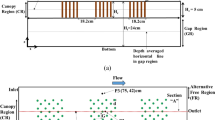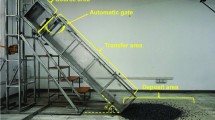Abstract
Our aim is to determine the run-out distance of the debris flow that is crucial in the assessment, prevention and control of the debris flow hazard. Based on the variation characteristic of debris flow velocity in the alluvial fan, this paper proposes the calculation method of the velocity attenuation coefficient of the debris flow. By defining the velocity attenuation coefficient and deducing its calculating formula, this paper puts forward a new method to determine the run-out distance of the debris flow based on the velocity attenuation coefficient, and Gangou debris flow in Luding County, Sichuan Province is selected as a case for calculation and verification. Having 10 m as its measuring spacing, this paper measured 19 sections at the alluvial fan of the Gangou debris flow (among them, 11 sets of data are valid). And based on the measurement, this paper analyzes the characteristic of the velocity attenuation and calculates its velocity attenuation coefficient after the 2005 debris flow. The study indicates that when the velocity of Gangou debris flow at the alluvial fan is greater than 12 % of the initial velocity (at the mouth of gully), the attenuation is quite remarkable. But when the velocity at the alluvial fan is less than 12 % of the initial velocity, the attenuation is quite slow. Besides, when Gangou debris flow rushes out of the gully mouth (the initial velocity is 10 m/s) and when it attenuates to the 32 time, its velocity is less than 0.1 m/s, the debris flow is considered to stop flowing, and the run-out distance of Gangou debris flow is calculated to be 320 m. But the present alluvial fan of Gangou debris flow is measured to be 285 m in length, and the calculated run-out distance is 320 m, which is 35 m longer than its present length. This means when the debris flow runs out in 2005, it blocked up the main river (Dadu River) in some extent. And this finding is generally in accordance with that from the field survey. The findings can be of theoretical and practical significance in the debris flow hazard assessment, as well as its prevention and mitigation.





Similar content being viewed by others
References
Ardell BW, Cesca M, Huggel C, Scheuner T, Graf C, Christen M (2007) Numerical modeling of debris flow run-out in the Swiss Alps. Geol Soc Am Abstr Programs 39:438–445
Carlos P, Jeffrey M, Craig S, Frans K (2004) Observations and numerical modeling of debris flows in the Na Kika Basin, Gulf of Mexico. Offshore Technology Conference, Houston, May (3–6), pp 1–13
González E, Herreros MI, Pastor M, Quecedo M, Merodo JA (2003) Discrete and continuum approaches for fast landslide modeling. Numerical modeling in micromechanics via particle methods, proceedings of the 1st international PFC symposium, Gelsenkirchen. Lisse, AA Balkema, pp 307–313
Kang ZC, Li ZF, Ma AN, Luo JT (2004) Debris flow research in China. Science Press, Beijing
Marcel H, Ramon C, Joan A (2006) Detailed debris flow hazard assessment in Andorra: a multidisciplinary approach. Geomorphology 78:359–372
Miyazawa N, Tanishima T, Sunada K, Oishi S (2003) Debris flow capturing effect of grid type steel-made sabo dam using 3D distinct element method. Proceedings of the third international conference on debris flow hazard mitigation, Netherlands, pp 527–538
O’Brien JS, Julien PY, Fullerton WT (1993) Two-dimensional water flood and mudflow simulation. J Hydraulic Eng 119:244–261
Sosio R, Pozzoni M, Ambrosi C, Crosta GB (2006) Modeling the debris flow expansion on alluvial fan areas—a comparison of different modeling approaches. Geophys Res Abstr 8:304–311
Tang C (1994) Numerical simulation of debris flow inundation on the alluvial fans and its prediction model of the risk areas. J Soil Water Conserv 8(1):11–15
Wang JK, Huang RJ, Ding XY (1996) Debris flow prevention technology. China Railway Press, Beijing
Wei FQ, Hu KH, Lope JL, Cui P (2003) The method and application of momentum partitions in debris flow hazards. Chin Sci Bull 48(3):298–301
Zhao ZX, He JJ (2010) Hydraulics. Tsinghua University Press, Beijing
Acknowledgments
This research has been supported by The National Natural Science Foundation of China (Project No. 41101086), Special Research Fund of State Key Laboratory of Geohazard Prevention and Geoenvironment Protection, Chengdu University of Technology (SKLGP2012K003) and The Basic Research Project from Ministry of Science and Technology (2011FY110101). The author would like to thank Ruge Xu from Chinese Geological Survey, Chengdu Center, for his field survey work. The author also thanks Dr. Thomas Glade the editor-in-chief of Natural Hazards and innominate peer reviewers for their valuable comments and suggestions which improved the quality of the paper.
Author information
Authors and Affiliations
Corresponding author
Rights and permissions
About this article
Cite this article
Tie, Y. Prediction of the run-out distance of the debris flow based on the velocity attenuation coefficient. Nat Hazards 65, 1589–1601 (2013). https://doi.org/10.1007/s11069-012-0430-z
Received:
Accepted:
Published:
Issue Date:
DOI: https://doi.org/10.1007/s11069-012-0430-z




